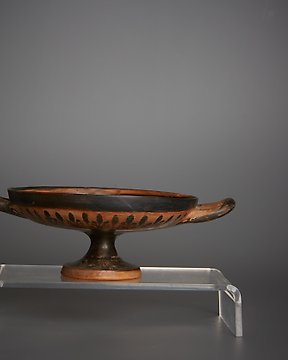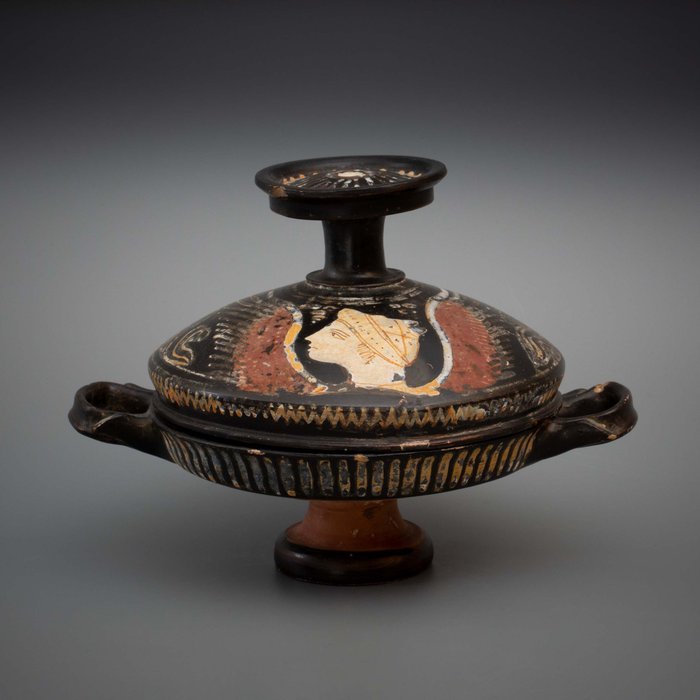
古希臘,邁錫尼 陶瓷 基利克斯。西元前4世紀。直徑21公分。
編號 84323597

編號 84323597

LEKANIS
Magna Grecia, Gnathia · 4th century B.C.
Pottery
Length between handles 17 cm and height 11,5 cm
Provenance
- Sotheby's, London, 1968.
- Private collection, Delaware (USA), until 2023.
Condition
Good state of conservation, without restorations.
Documents
- Thermoluminescence test attached.
Published
- Sotheby's, London, Antiquities, January 29, 1968. Lot 144.
Lekanis decorated with black varnish and polychromy in white, ocher and red tones. It has a tank in the shape of a low and wide cup, with straight walls that open slightly towards the mouth, with a short stem with a rounded base and two horizontal handles in the shape of a ribbed ribbon, with bevel-cut stems on both sides. The mouth features an interior stepping that allows the lid to sit securely. This lid shows a structure similar to that of the body, with a domed elevation and a staggered and flat vertical finish, which allows the lid to be supported to use it as a container, inverting it. A similar lekanis is preserved in the British Museum in London (fig. 1), both in its typology and in the ornamental design, although in this case there are no details painted in red.
The decoration of the vase is of great richness, combining a central figurative motif with secondary geometric and plant elements that cover practically the entire piece. The lid houses the main motif, a winged female face in profile to the left, with a fine necklace and a turban-like textile headdress called saccos. Her face appears painted in white, with the details drawn in ocher. The wings are red with white outlines. Unfolding on both sides of the figure, vegetal scrolls that undulate sinuously covering the rest of the surface of the lid. The lower profile of this appears differentiated with a zigzag frieze, and the upper part of the finial houses a radial motif based on smooth lines. The body is decorated with a wide band of parallel vertical stripes, evoking the ribs of contemporary metal cups. The foot remains free of decoration, in the red color of the clay, although its lower profile appears varnished in black. The inside of the foot, although it remains hidden, is decorated with two inscribed circles, also in black varnish.
The lekanis or lecanide is a type of Greek pottery in the shape of a wide and low cup, with a narrow foot and two horizontal handles in the mouth. The upper rim was shaped to accommodate a lid nearly the same size as the cup, which fitted over the cup without gap or interruption, forming a continuous wall. The lecanide was used as a jeweler and ointment, which is why it was sometimes associated with marriage rituals, forming part of the bride's dowry. In fact, they will frequently display bridal decorations. In addition, as in this case, the interior is compartmentalized to facilitate the placement of items to be preserved, a clear sign of its use as a jewelry box.
Although there are some precedents in the geometric period, the typology takes its final form in the second half of the sixth century B.C. Due to its sumptuary use, it was one of the forms preferred by ceramic painters; in the time of the black figures they used to be without a lid, but with the advent of the red figures the lid will be an important element, and it will appear richly decorated. Its shape will evolve from the original domed profile, flattening out until it almost forms a right angle with the mouth of the glass. This lid also incorporates a wide and flat upper finial, which could allow the lid to be used as a second cup.
Since the end of the 5th century BC, when Attic ceramics went into decline, productions developed. ceramics typical of the colonies of Magna Graecia. These Italian artists will use Attic forms and techniques, but will add their own peculiarities on a formal level.
In the Apulia region, north of the Gulf of Taranto and east of the Apennine mountains, the main ceramic producing center was located Magna Graecia painted. There two parallel styles would be developed: one called Simple Style and another known as Ornate. The former avoided using colors other than the basic red and black of the red-figure technique, and was mainly used for small vases such as the bell krater. The second was preferably used for larger vessels, such as volute kraters, amphorae, loutrophoroi, and hydrias. The compositions of this Ornate Style came to represent up to twenty figures, many of them floating, without a ground plane, and often organized in two or more registers. This language was also characterized by the rich use of color, especially red, ocher and white.
Gnathia vases make up an independent group within the Ornate Style Apula ceramics, and date from the last quarter of from the 4th century B.C. and end of III. They have been found in Apulia, Paestum and Campania, although the group takes its name from the Apulian city of Gnathia, present-day Egnazia, where the first examples were discovered. They are distinguished from the rest of the production of Magna Graecia by the technique of their polychromy; unlike the red-figure pieces, the Gnathia vases were completely covered in a black varnish on the
Bibliography
- BOARDMAN, J. The History of Greek Vases: Potters, Painters, Pictures. Thames & Hudson. 2001.
- Corpus Vasorum Antiquorum. Paris: Union Académique Internationale, www.cvaonline.org
- DENOYELLE, M.; IOZZO, M. La céramique grecque d’Italie Méridionale et de Sicile. A. J. Picard. 2009.
- HURSCHMANN, R. “Gnathiavasen”, en Der Neue Pauly, vol. 4, cols. 1106-1107. Metzler Verlag. 1998.
- MAYO, M. (ed.). The Art of South Italy, Vases from Magna Graecia. Richmond. 1982.
Notes:
- The piece includes authenticity certificate.
- The piece includes Spanish Export License.
- The seller guarantees that he acquired this piece according to all national and international laws related to the ownership of cultural property. Provenance statement seen by Catawiki.